Date of Report: 20th July 2022
This is the second quarterly report of 2022 and covers the period from late April through to the end of July.
Marton Mere has been a Site of Special Scientific Interest (SSSI) since 1979 and a Local Nature Reserve (LNR) since 1991
A fabulous, accessible green space for Residents, Tourists, birders and other naturalists alike, the site and Fylde Bird Club share a rich history, with many Bird Club members being heavily involved in the site becoming an SSSI and LNR and in producing a record of bird, mammal, insect and plant observations over the last 70 years.
The site itself is Council owned and its designation as a SSSI means that the site has to have a Management Plan in place; this plan ensures that the condition of the site when the SSSI was awarded (1979) remains consistent over time and that all habitats are managed to maintain this.
The Management Plan and associated programme of work has in the past been managed and updated by Blackpool Council but this has now not been done for a number of years with COVID being main reason given for this. However, the Club and the volunteers are now actively working with the Council and other Stakeholders to bring these documents up to.
The majority of the works carried out at the Mere are actually undertaken and delivered by a Volunteer groups who attend the site on Tuesdays, all year round. There was Thursday group but this has now been disbanded.
The recently appointed Volunteer Co-ordinator, Alec Lynott,is doing great work and has been a breath of fresh air – Alec spends a lot of time at the Marton Mere Visitor Centre, located on the Holiday Park.
Should any Fylde Bird Club Members wish to join the Volunteer group / Friends of Marton Mere then please email Alec Lynott using the email address alec.lynott@blackpool.gov.uk
As the period covered by this report coincides with the breeding season, a lot of the work referenced and undertaken relates to keeping access paths and hides clear and making sure that boundary fencing remains in order. The hard work will start again in September and continue through to March 2023.
1. Litter report
From the beginning of May through to 26th July, 32 full bags of litter were collected by volunteers. On most days, volunteers tend to arrive early and carry out a full ‘sweep’ of the Mere perimeter and the hides; the majority of the litter collected is centred around the hides and is a result of anti-social behaviour and impromptu ‘parties’. This often includes broken glass, cans and the remnants of fires that have been started. Where a normal litter pick is not sufficient, a team will be sent with brushes, shovels and a wheelbarrow to clear the areas and leave them safe for visitors.
Lots of work was done late 2021 and early 2022 to create dead-hedging and laid hedging barriers along many of the paths around the Mere. In general, this work has proved to have been really effective and almost every area where a barrier was created has seen an almost complete reduction in off path activity by off lead dogs and people. This is in particular evidence around the North East corner of the Mere where quite a lot of the Willow used in the dead hedging has actually started to grow. Several ‘paths’ into the Mere and reedbeds that were present have now completely grown over and many plants have thrived as a result.
Loose dogs remain an issue and around 50% of dogs encountered around the Mere are offlead, contrary to requirement for all dogs to be on leads.
Dog fouling is an issue but not a huge one – if dogs are off leads, running around in long grass and scrub, how would an owner know it had fouled! We tend to only find out when it’s too late and a strimmer makes contact with the offending item.
Several weeks work for a number of teams has been undertaken making repairs to perimeter fencing around the Mere and also around Lawsons Showground.
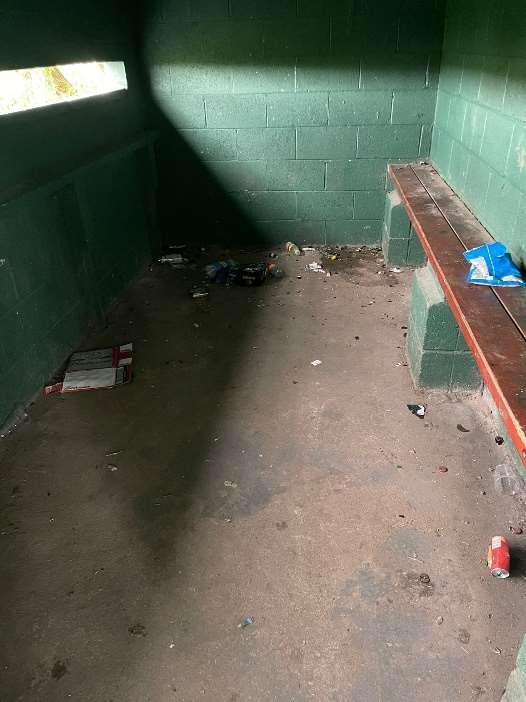
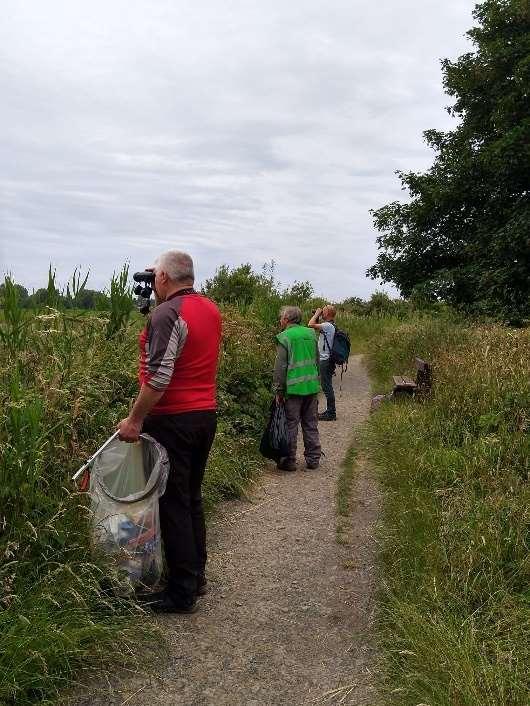
Around 25m of wire fencing has been replaced around the Northern edge of the Mere between the path and the paddock area – this fencing does not prevent access by dogs but is a barrier to people –again you can see that routes taken by pedestrians into this area have already grown over and been reclaimed by nature.
Work was also done replacing around 25m of timber fencing between the showground and Lawsons Road, towards the junction with East Park Drive –whether this is work the volunteers should be doing is for debate but its completion has ensure that travellers and other vehicles cannot now access this area.
Two areas of dead-hedging were also ‘refreshed’ around two of the hides to ensure that they remained effective barriers that prevented access by dogs and pedestrians.
1.1 Litter Picking (Honestly) 1.2 Typical scene at Woodland Hide 2. Dogs 3. Fencing4. Path / Hide clearance
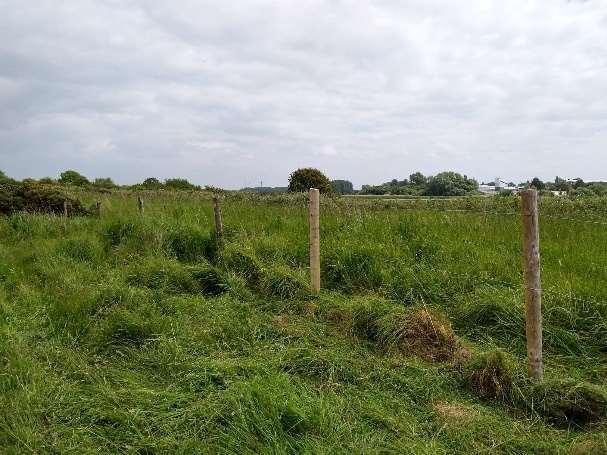
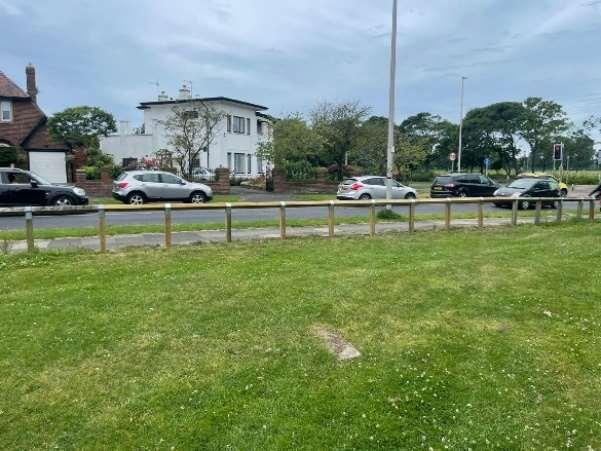
Around 400m of paths have been cleared of all overhanging and encroaching plants, shrubs and trees and this has maintained full accessible paths both around the Mere itself and also along paths that join the Mere with Kipling Drive and up to the back of the Holiday Park. This work is often carried out by hand with shears and loppers, but where appropriate, electric strimmers are used which certainly allows for a larger area to be covered during a shift. We also experienced some unseasonal winds during the period and several tree limbs were blown down and these were cut up and removed / added to dead hedging. The bramble has been particularly aggressive this year and nowhere more so than around the Teal Hide where it had almost covered the front of the hide. The area in front of the hide was cleared of bramble and the hide is now in use again.
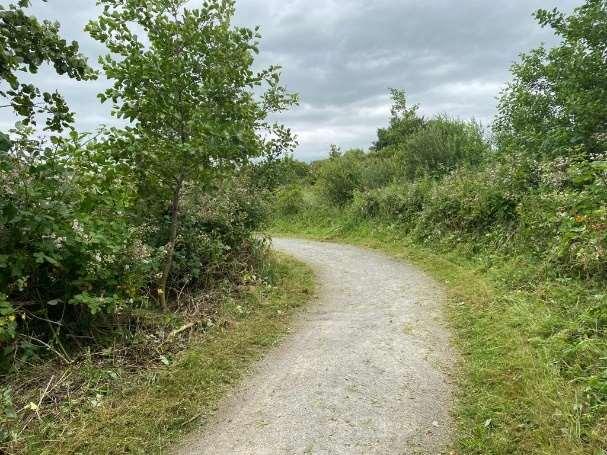
5. Invasive Species Control
As Spring turned to Summer there were several reports of Giant hogweed (Heracleum mantegazzianum). This is a plant in the Apiaceae family (previously known as the Umbelliferae) Which also includes some well-known plants such as parsley, carrot, parsnip, cumin and coriander. Giant Hogweed is potentially invasive and. More importantly, the sap can cause sever skin burns. As the areas observed were close to areas where the general public may come into contact with it, the plants needed to be removed to prevent unintended contact and injury. Work parties had to don all of the necessary personal protective equipment and were despatched to remove these patches.Where practical, the plant is dug up, and it is then cut into pieces, bagged and removed to a controlled area for disposal by Council employees. If the base cannot be reached (bramble patches being the
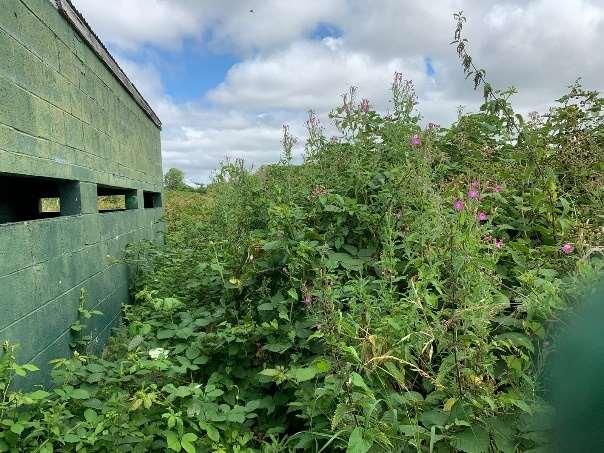 3.1 New perimeter fencing at Lawson Rd 3.2 Repaired / re-tensioned paddock fencing
4.1 Pathway edge clearance
4.2 Teal Hide before cutting back.
3.1 New perimeter fencing at Lawson Rd 3.2 Repaired / re-tensioned paddock fencing
4.1 Pathway edge clearance
4.2 Teal Hide before cutting back.
main reason), the plant stem is severed as low as possible and the cut items removed for disposal as above.
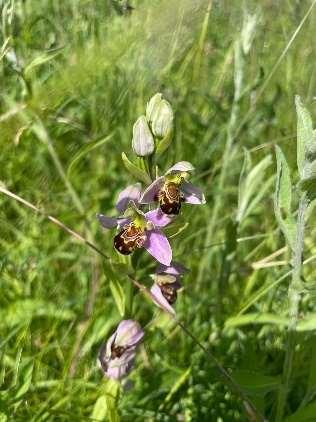
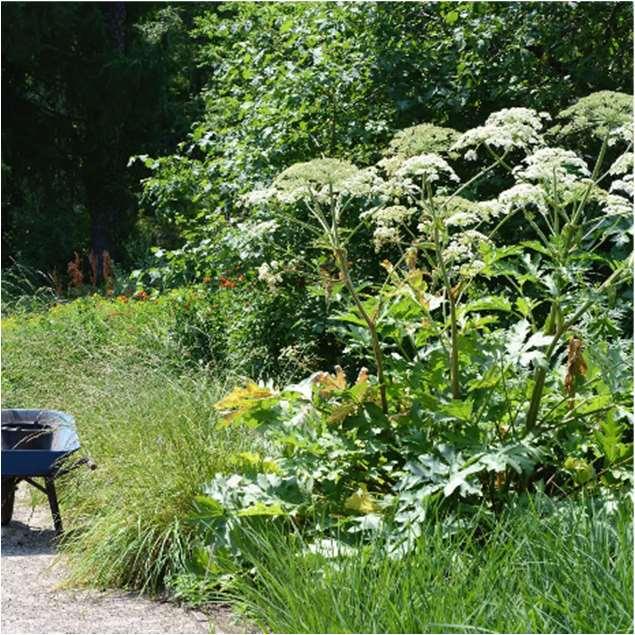
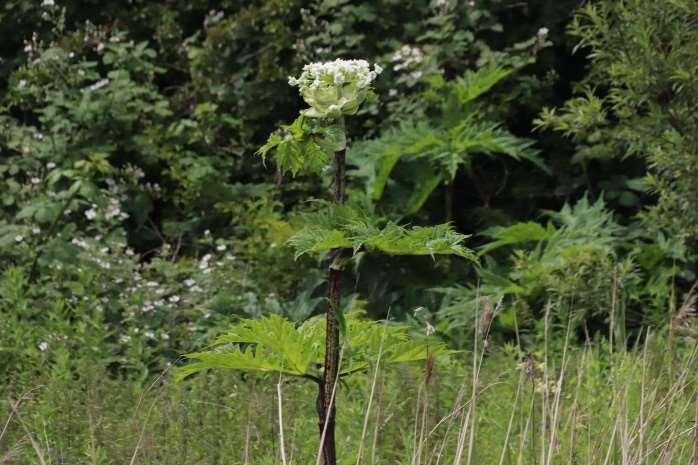
The wild flower meadow situated in the North East corner is specifically managed and surveyed to monitor plants, fungi and insects (particularly hoverflies and butterflies). It is essential that this areas is managed to prevent some species dominating and crowding out the intended meadow species. Some of this work was carried out recently when several volunteers spent a whole day in this area removing Broad Leaved Dock Rumex obtusifolius before it drops its seed – this resulted in over 15 bags being removed and some sore backs! The area along the Northern edge was also managed and verges cut back to encourage the growth of Birds-foot Trefoil (Lotus corniculatus) which in turn will hopefully attract the target butterfly species, Common Blue (Polyommatusicarus) – We have observed Blue butterflies here this year but not sufficiently close enough for a 100% ID. This same area also produced several spikes of Bee Orchid (Ophrysapifera) which serve to remind us just what wonderful thing nature is!
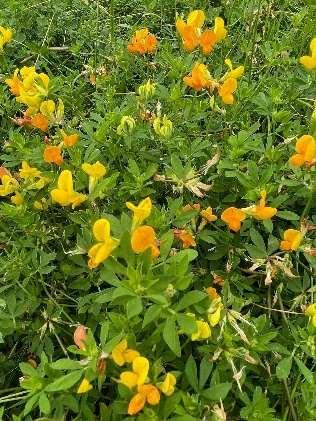
For many months, the access gates at the North West and South West corners of the Mere have been damaged and were either nailed/screwed closed (North West) or left wide open (South West). In the north West corner, this resulted in disabled access to the reserve not being possible – something that was repeatedly highlighted to the Council and Councillors. The open access to the South West corner was an open invitation to people on quad-bikes,
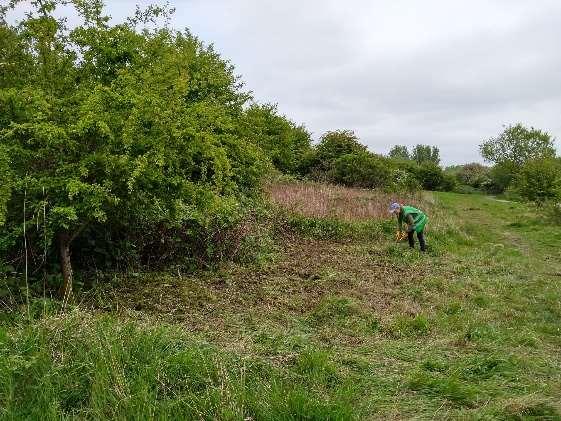 5.1Giant Hogweed
5.2 Typical Giant Hogweed patch
6. Wild flowerAreas and Meadow
6.1 North East Grassland Clearing 6.2 Bee Orchid 6.3 Birds-Foot Trefoil
7. Access Gates
5.1Giant Hogweed
5.2 Typical Giant Hogweed patch
6. Wild flowerAreas and Meadow
6.1 North East Grassland Clearing 6.2 Bee Orchid 6.3 Birds-Foot Trefoil
7. Access Gates
scooters and motorbikes to access the paths and use them and a private / off road race track. Lancashire Constabulary did provide increased presence around the Mere and PCSO’s did attend in the evenings – this undoubtedly helped and they did confiscate a number of bikes over the period. However, I am delighted to report that over the course of 20/21st July, two brand new, industrial grade gates have been installed at these two locations and this form of access to the site on motorised vehicles should now be much more difficult. Also associated with the access gates, the ‘kissing gate’, that is close to the Volunteers cabins, has always suffered from damage during heavy rains – water is channelled from the main path down towards the gate and the path material / gravel is subsequently washed away – this gets worse every time we experienced heavy rain. Work was therefore undertaken to provide a brick on edge drainage channel across this gate which now results in this rainwater being channelled away from the gate and into the Pumping compound without causing damage to the path – it seems to be working well and a similar solution is planned for the opposite side of the Mere adjacent to the outfall.
8. Survey Work – Site Visits
Two breeding warbler surveys have been carried out and details of these surveys can be provided.
Councillors have also been to the Mere to see the work that has been going on and there has also been a working party / management plan team meeting held on site on 20th July that Paul Ellis referred to at the FBCmonthly meeting on 26th July.
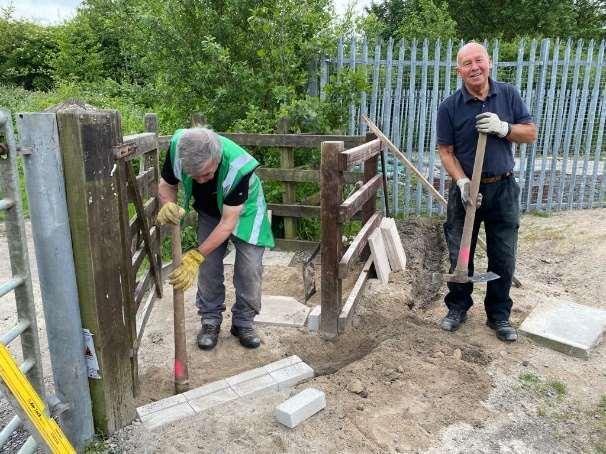
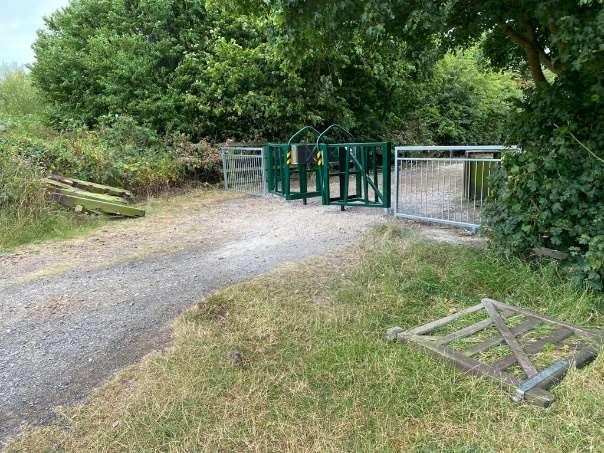
The Bird Club remains rightly involved in all matters relating to the Mere and for quite some time, they and the Volunteers have been the only voices speaking up for this outstanding location / natural resource – We may have started to be heard and I hope there is more to report later in the year.
The Mere remains a key habitat for all manner of flora and fauna and Club members have been key to its protection and management for over 70 years. It is only with the efforts of Volunteer groups that it remains in good condition and the account and images above are typical of the type of things you could be involved with should you choose to join the volunteers groups (We also do quite a bit or birding just don’t tell Alec).
For more information and photos, please follow this link to the Marton Mere Facebook page https://www.facebook.com/martonmerereserve
3.1 One of the two new gates installed. 3.2 Drain at Kissing Gate